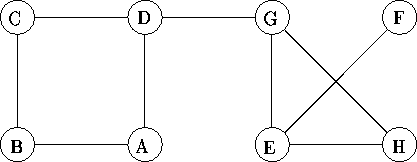当前你的浏览器版本过低,网站已在兼容模式下运行,兼容模式仅提供最小功能支持,网站样式可能显示不正常。
请尽快升级浏览器以体验网站在线编辑、在线运行等功能。
1646:Network Wars
题目描述
It is the year 2126 and comet Swift-Tuttle has struck the earth as predicted. The resultant explosion emits a large cloud of high energy neutrons that eliminates all human life. The accompanying electro-magnetic storm causes two unusual events: many of the links between various parts of the electronic network are severed, and some postgraduate AI projects begin to merge and mutate, in much the same way as animal life did several million years ago. In a very short time two programs emerge, Paskill and Lisper, which move through the network marking each node they visit: Paskill activates a modified Prolog interpreter and Lisper activates the `Hello World' program. However `Hello World' has mutated into an endless loop that so ties up the node that no other program, not even Lisper, can re-enter that node and the Prolog interpreter immediately reverse compiles (and destroys) any program that enters. However, Paskill knows which nodes it has visited and never tries to re-enter them. Thus if Lisper attempts to enter a node already visited by Paskill it will be annihilated; neither can enter a node already visited by Lisper, if either (or both) cannot move both will halt and if they ever arrive at a node simultaneously they annihilate each other. Both programs move through the network at the same speed.
Write a program to simulate these events. All nodes in the the network are labelled with a single uppercase letter as shown below. When moving to the next node, Paskill searches alphabetically forwards from the current node, whereas Lisper searches alphabetically backwards from the current node, both wrapping round if necessary. Thus, (in the absence of the other) if Paskill enters the network below at A, it would visit the nodes in the order A, B, C, D, G, H, E, F; if Lisper enters the network at H it would visit them in the order H, G, E, F. Simulation stops when one or more of the above events occurs. If more than one event occurs, mention Paskill first.

Write a program to simulate these events. All nodes in the the network are labelled with a single uppercase letter as shown below. When moving to the next node, Paskill searches alphabetically forwards from the current node, whereas Lisper searches alphabetically backwards from the current node, both wrapping round if necessary. Thus, (in the absence of the other) if Paskill enters the network below at A, it would visit the nodes in the order A, B, C, D, G, H, E, F; if Lisper enters the network at H it would visit them in the order H, G, E, F. Simulation stops when one or more of the above events occurs. If more than one event occurs, mention Paskill first.

输入解释
Input will consist of a series of lines. Each line will describe a network and indicate the starting nodes for the two programs. A network is described as a series of nodes separated by `;' and terminated by a period (`.'). Each node is described by its identifier, a `:' and one or more of the nodes connected to it. Each link will be mentioned at least once, as will each node, although not all nodes will be `described'. After the period will appear the labels of the starting nodes--first Paskill and then Lisper. No line will contain more than 255 characters. The file will be terminated by a line consisting of a single #.
输出解释
Output will consist of one line for each network. Each line will specify the terminating event and the node where it occurs. The terminating event is one or two of the following:
Lisper destroyed in node ?
{Paskill/Lisper} trapped in node ?
Both annihilated in node ?
Lisper destroyed in node ?
{Paskill/Lisper} trapped in node ?
Both annihilated in node ?
输入样例
A:BD;C:BD;F:E;G:DEH;H:EG. A H E:AB. A B B:ACD. B D A:B;B:C;D:E. A D #
输出样例
Paskill trapped in node D Lisper trapped in node F Both annihilated in node E Lisper destroyed in node B Lisper trapped in node E
来自杭电HDUOJ的附加信息
| Recommend | zl |
最后修改于 2020-10-25 22:46:49 UTC 由爬虫自动更新
共提交 0 次
通过率 --%
| 时间上限 | 内存上限 |
| 2000/1000MS(Java/Others) | 65536/32768K(Java/Others) |
登陆或注册以提交代码